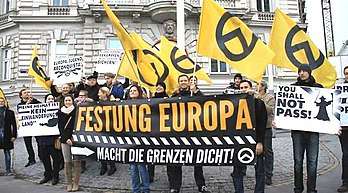Fortress Europe
Fortress Europe (German: Festung Europa) was a military propaganda term used by both sides of the Second World War which referred to the areas of Continental Europe occupied by Nazi Germany, as opposed to the United Kingdom across the Channel.

World War II defenses
In British phraseology, Fortress Europe meant the battle honour accorded to Royal Air Force and Allied squadrons during the war, but to qualify, operations had to be made by aircraft based in Britain against targets in Germany, Italy and other parts of German-occupied Europe, in the period from the fall of France to the Normandy invasion.
Simultaneously, the term Festung Europa was being used by Nazi propaganda, namely to refer to Hitler's and the Wehrmacht's plans to fortify the whole of occupied Europe, in order to prevent invasion from the British Isle's troops. These measures included the construction of the Atlantic wall, along with reorganization of the Luftwaffe for air defense. This use of the term Fortress Europe was subsequently adopted by correspondents and historians in the English language to describe the military efforts of the Axis powers at defending the continent from the Allies.
Postwar usage

Currently, within Europe, the term is used either to describe dumping effect of external borders in commercial matters,[1] or as a pejorative description of the state of immigration into the European Union. This can be in reference either to attitudes toward immigration, to border fortification policies pursued for instance in the Spanish North African enclaves of Ceuta and Melilla[2] or to the system of border patrols and detention centers that are used to help prevent illegal immigration into the European Union.[3]
For conservative parties such as the Freedom Party of Austria, 'Fortress Europe' is a positive term. They mostly claim that such a fortress does not really exist yet, and that illegal immigrants can enter Europe far too easily. They often charge the southern states with insufficient border control, claiming that the latter are acting on the knowledge that immigrants tend to be more attracted to western/northern states with more generous welfare systems (Switzerland, Germany, Austria, Sweden etc.). Conservatives all over Europe want to end the Schengen Agreement and to re-install border controls because they say it leads to mass migration of illegals and also free traffic of criminals.[4] Changes in the Schengen treaties have come into effect in the wake of this criticism.[5]
Controlled external borders
- Ceuta and Melilla (Spain) (from Morocco)
- Italian and Maltese coast (from Libya and Tunisia)
- Canary Islands (Spain) (from Morocco)
- Maritsa (Turkey) (from Near East)
- Eastern border of the European Union (from Ukraine, Belarus, Moldova, Russia)
- South-Eastern border of the European Union (from Bosnia and Herzegovina, Serbia, Montenegro, Albania, North Macedonia)
- Strait of Gibraltar (from Morocco)
- South Aegean and North Aegean (from Near East)
See also
- Hindenburg Line, German defences on the Western Front of World War I
- Siegfried Line, German defences against France in World War II
- Maginot Line, French defenses against Germany constructed for World War II
- Iron Curtain, dividing line through Europe during the Cold War
- Salpa Line, The last fortified defence line of Finland against the Soviet Union in World War II
References
- J. Hyun, Korean Automotive Foreign Direct Investment in Europe: Effects of Economic Integration Motivations and Patterns of FDI and Industrial Location, Springer, 2003, p. 101.
- Castan Pinos, J. (2009) 'Building Fortress Europe? Schengen and the Cases of Ceuta and Melilla' Centre for International Border Research (CIBR)-WP18/2009: 1-29.
- "Autonomous rear Entrances to Fortress Europe?!". indymedia.org.uk.
- The City Paper Staff. "An end to Schengen?". The City Paper Bogotá.
- "EU moves to end passport-free Schengen travel". Telegraph.co.uk. 12 May 2011.
